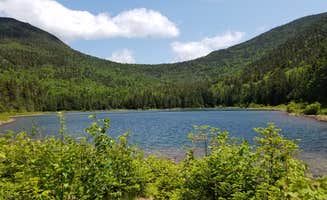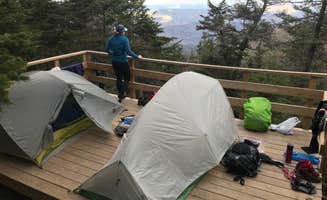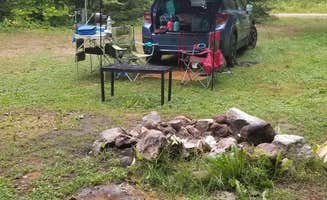Dispersed camping options near Laconia, New Hampshire cluster around the White Mountain National Forest, with multiple areas accessible within a 45-60 minute drive. The region features elevations ranging from 500 to 2,500 feet with significantly cooler temperatures at higher elevations, often 10-15°F lower than in Laconia proper. Camping season typically runs from late May through mid-October, with many forest roads remaining impassable until snowmelt and spring maintenance are complete.
What to do
Riverside activities: Town Hall Road Dispersed offers excellent water access with fishing opportunities. "We drove down the road a bit, past a few tent sites just off the road. Down toward the river there was plenty of open space so we pitched there and built a fire pit. There are trout in the river and if you cross and go through the woods to the right there's some great spots to explore further!" notes camper Erin H.
Mountain hiking: The area surrounding Guyot Shelter connects to extensive trail networks. "We got to the site, claimed our platform and hiked over to West Bond to catch a beautiful sunset," reports Hollie G. The shelter serves as a strategic base for accessing multiple 4,000-foot peaks.
Swimming holes: Several sites offer natural swimming opportunities during summer months. "The road ends at the Little River, offering fishing and swimming options," according to Jean C. regarding Haystack Road. Local swimming holes provide cooling relief during July and August when daytime temperatures can reach the upper 80s.
Wildlife viewing: Early mornings offer the best opportunities for wildlife spotting. "You may see moose or bears in the area," notes a reviewer about Haystack Road. Dawn and dusk provide optimal viewing times, particularly near water sources.
What campers like
Site privacy: Elbow Pond Road Dispersed Site provides campers with varied levels of seclusion. "Some of the camping spots have fire pits but not all. Some of the sites are close together but there are some that are a good distance apart," explains Dom L. This flexibility allows visitors to choose their desired level of isolation.
Water proximity: Many campers prioritize sites near streams or ponds. "The first few sites on the left have a small stream behind them, it'll make your stay a little easier. Bathing, dishes, etc," advises Greg L. about Haystack Road. Water access significantly improves the primitive camping experience.
Spacious group areas: Several locations accommodate larger parties. "About the fifth one or so, you pull in and the fire pit is right there. Then walk down a bit and there's a large group site with another pit," describes Erin H. about Town Hall Road Dispersed. These areas work well for family reunions or friend gatherings.
Quiet weekday camping: Mid-week visits dramatically improve site selection. "Great spot for the weekdays, hardly anyone around and got a great site right by the river (mid-Sept.)," reports Ali B. Most dispersed areas fill quickly on weekends, especially between Memorial Day and Labor Day.
What you should know
Bear awareness: Wildlife encounters require proper preparation. "Wildlife like bear and moose will visit you at night. It's almost a certainty, keep your food locked in a bear tight container," warns Greg L. about Haystack Road. Bear canisters are strongly recommended as food storage options.
Site security concerns: Some areas experience theft issues. At Haystack Road, one camper reported, "I left out gear to claim a spot while out hiking and came back to people having stolen some of it as well as setting up in that spot." Never leave valuables unattended.
Road conditions: Access to many sites requires appropriate vehicles. "The road in is pretty rough and is not recommended for sedans or lower riding cars," cautions Dom L. about Elbow Pond Road. High-clearance vehicles perform best on forest roads, especially after rain.
Limited amenities: Expect truly primitive conditions. "You get a fire pit and that's it," explains Kim O. Dispersed sites lack potable water, trash service, and toilet facilities, requiring comprehensive packing lists and strict adherence to Leave No Trace principles.
Tips for camping with families
Platform camping options: Guyot Shelter provides structured camping areas better suited for families with children. "This is a very large campground. With a large shelter renovated in 2019. Approx 10 platform sites. Some are very isolated and some with great views," explains Jerome S. These platforms keep tents off potentially wet ground.
River access for kids: Sites with gentle water features provide natural entertainment. "There were plenty of sites to choose from and most (not all) had access to the river as well as a fire ring," reports Josie W. about Town Hall Road. Shallow streams offer safer play areas than deeper swimming holes.
Weekday scheduling: School-aged families benefit from less competition for sites outside peak times. "We were lucky to snag on one a Monday afternoon (last site before turnaround on FR38) and stayed all week," notes Rebecca B. Monday arrivals maximize site selection opportunities.
Site selection strategy: Arrive with backup options mapped out. "They have a couple different spots where you can park and walk up to your site or they have sites you can pull right up next to them," explains Dom L. about Elbow Pond Road. Drive-up sites work better for families with younger children or mobility concerns.
Tips from RVers
Size restrictions: Most dispersed sites accommodate smaller rigs only. "There was only a 20 foot by 12 foot space to camp in with no water, no dumpster, no toilet, no view of anything and lots of other campers that appear to be long term residents," warns Kevin C. about Elbow Pond Road Dispersed Site. Trailers exceeding 20 feet encounter significant limitations.
Backing challenges: Forest roads often lack turnaround spaces. "Had to back my trailer about a quarter mile, so they could get out," reports Kevin C. at Elbow Pond. Practice trailer backing skills before attempting these narrow access roads.
Solar considerations: Tree coverage impacts power generation. "If you need solar or starlink, there's only 1 or 2 viable spots," notes Rebecca B. Most dispersed sites have dense tree coverage, limiting solar panel effectiveness.
Leveling requirements: Prepare for uneven terrain at most sites. "Town Hall Road is a long road with many designated dispersed sites, all far apart from each other and all varying in levelness and size." Bring leveling blocks and stabilizers for camper comfort.






